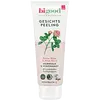What's inside
What's inside
 Key Ingredients
Key Ingredients

 Benefits
Benefits

 Concerns
Concerns

 Ingredients Side-by-side
Ingredients Side-by-side

Water
Skin ConditioningGlycerin
HumectantAloe Barbadensis Leaf Juice
Skin ConditioningCaprylyl/Capryl Glucoside
CleansingCoco-Glucoside
CleansingPerlite
AbsorbentXanthan Gum
EmulsifyingGlyceryl Oleate
EmollientParfum
MaskingCitric Acid
BufferingSodium Benzoate
MaskingPotassium Sorbate
PreservativeLimonene
PerfumingLinalool
PerfumingTrifolium Pratense Flower Extract
AstringentTocopherol
AntioxidantHydrogenated Palm Glycerides Citrate
EmollientWater
Skin ConditioningSodium C14-16 Olefin Sulfonate
CleansingPropanediol
SolventCellulose Acetate
Caprylyl/Capryl Glucoside
CleansingAcrylates Copolymer
Coco-Glucoside
CleansingGlyceryl Oleate
EmollientSodium Cocoamphoacetate
CleansingGlycerin
HumectantAloe Barbadensis Leaf Juice
Skin ConditioningCaprylic/Capric Triglyceride
MaskingBenzyl Alcohol
PerfumingCocamidopropyl Hydroxysultaine
CleansingEthylhexylglycerin
Skin ConditioningBisabolol
MaskingHydrolyzed Jojoba Esters
Skin ConditioningSclerotium Gum
Emulsion StabilisingSodium Hydroxide
BufferingRosmarinus Officinalis Leaf Oil
MaskingSalicornia Herbacea Extract
Skin ConditioningTetrasodium EDTA
Lavandula Angustifolia Oil
MaskingCamellia Oleifera Leaf Extract
AstringentAvena Sativa Kernel Extract
AbrasiveWater, Sodium C14-16 Olefin Sulfonate, Propanediol, Cellulose Acetate, Caprylyl/Capryl Glucoside, Acrylates Copolymer, Coco-Glucoside, Glyceryl Oleate, Sodium Cocoamphoacetate, Glycerin, Aloe Barbadensis Leaf Juice, Caprylic/Capric Triglyceride, Benzyl Alcohol, Cocamidopropyl Hydroxysultaine, Ethylhexylglycerin, Bisabolol, Hydrolyzed Jojoba Esters, Sclerotium Gum, Sodium Hydroxide, Rosmarinus Officinalis Leaf Oil, Salicornia Herbacea Extract, Tetrasodium EDTA, Lavandula Angustifolia Oil, Camellia Oleifera Leaf Extract, Avena Sativa Kernel Extract
Ingredients Explained
These ingredients are found in both products.
Ingredients higher up in an ingredient list are typically present in a larger amount.
Aloe Barbadensis Leaf Juice comes from leaves of the aloe plant. Aloe Barbadensis Leaf Juice is best known for helping to soothe sunburns. It is also anti-inflammatory, moisturizing, antiseptic, and can help heal wounds.
Aloe is packed with good stuff including Vitamins A, C, and E. These vitamins are antioxidants, which help fight free-radicals and the damage they may cause. Free-radicals are molecules that may damage your skin cells, such as pollution.
Aloe Barbadensis Leaf Juice also contains sugars. These sugars come in the form of monosaccharides and polysaccharides, folic acid, and choline. These sugars are able to help bind moisture to skin.
It also contains minerals such as calcium, 12 anthraquinones, fatty acids, amino acids, and Vitamin B12.
Learn more about Aloe Barbadensis Leaf JuiceCaprylyl/Capryl Glucoside is an alkyl glucoside. This just means it is creating by reacting alcohol and sugar. It is a cleansing and foaming ingredient.
Caprylyl/Capryl Glucoside helps remove the dirt, oil, and other pollutants from your skin.
Coco-Glucoside is a surfactant, or a cleansing ingredient. It is made from glucose and coconut oil.
Surfactants help gather dirt, oil, and other pollutants from your skin to be rinsed away.
This ingredient is considered gentle and non-comedogenic. However, it may still be irritating for some.
Learn more about Coco-GlucosideGlycerin is already naturally found in your skin. It helps moisturize and protect your skin.
A study from 2016 found glycerin to be more effective as a humectant than AHAs and hyaluronic acid.
As a humectant, it helps the skin stay hydrated by pulling moisture to your skin. The low molecular weight of glycerin allows it to pull moisture into the deeper layers of your skin.
Hydrated skin improves your skin barrier; Your skin barrier helps protect against irritants and bacteria.
Glycerin has also been found to have antimicrobial and antiviral properties. Due to these properties, glycerin is often used in wound and burn treatments.
In cosmetics, glycerin is usually derived from plants such as soybean or palm. However, it can also be sourced from animals, such as tallow or animal fat.
This ingredient is organic, colorless, odorless, and non-toxic.
Glycerin is the name for this ingredient in American English. British English uses Glycerol/Glycerine.
Learn more about GlycerinGlyceryl Oleate is the ester of glycerin and oleic acid. This ingredient is mainly an emollient and emulsifier.
Emollients soften and hydrate the skin by creating a thin film on top to trap in moisture. As an emulsifier, glyceryl oleate helps stabilize formulations by preventing ingredients such as oil and water from separating. According to a manufacturer, this ingredient helps helps thicken water-in-oil formulations, shower gels, and hair shampoos.
In some products, this ingredient may be used as a fragrance / perfuming ingredient. The scent of this ingredient is described to be "waxy".
Glyceryl oleate is created from oils rich in oleic acid, such as peanut oil and olive oil.
This ingredient may not be malassezia folliculitis safe.
Learn more about Glyceryl OleateWater. It's the most common cosmetic ingredient of all. You'll usually see it at the top of ingredient lists, meaning that it makes up the largest part of the product.
So why is it so popular? Water most often acts as a solvent - this means that it helps dissolve other ingredients into the formulation.
You'll also recognize water as that liquid we all need to stay alive. If you see this, drink a glass of water. Stay hydrated!
Learn more about Water